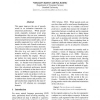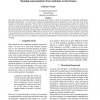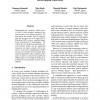108 search results - page 19 / 22 » Latent Semantic Word Sense Induction and Disambiguation |
SAC
2009
ACM
14 years 2 months ago
2009
ACM
Incorporating background knowledge into data mining algorithms is an important but challenging problem. Current approaches in semi-supervised learning require explicit knowledge p...
SEMWEB
2007
Springer
14 years 1 months ago
2007
Springer
A new paradigm in Semantic Web research focuses on the development of a new generation of knowledge-based problem solvers, which can exploit the massive amounts of formally speciļ¬...
ACL
2010
13 years 5 months ago
2010
This paper improves the use of pseudowords as an evaluation framework for selectional preferences. While pseudowords originally evaluated word sense disambiguation, they are now c...
LREC
2010
13 years 8 months ago
2010
This paper presents a geometric approach to meaning representation within the framework of continuous mathematics. Meaning representation is a central issue in Natural Language Pr...
EMNLP
2008
13 years 8 months ago
2008
Bootstrapping has a tendency, called semantic drift, to select instances unrelated to the seed instances as the iteration proceeds. We demonstrate the semantic drift of bootstrapp...



